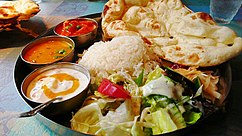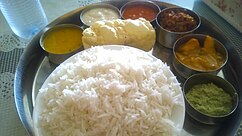Indian vegetarian cuisine
This article needs additional citations for verification. (September 2016) |
India is a strange country. People do not kill
any living creatures, do not keep pigs and fowl,
and do not sell live cattle.
—Faxian, Before 4th/5th century CE
Chinese pilgrim to India[1]
India has the world's largest number of vegetarians.[2][3] Vegetarianism has been present in India since antiquity[4] although a non-vegetarian diet may be present even on the highest priest caste.[5] Many Indians who do not regularly follow a vegetarian diet may adopt one during religious festivals [source needed].
Also, many Indian vegetarians eschew eggs as well as meat.[6] There are many vegetarian cuisines across India.[7]
Air catering[edit | edit source]
On demand most airlines offer Indian vegetarian dishes. Some regard these as dietary meals, some as religious meals. Details may vary.
Pre-ordering the IATA meal code AVML (Asian vegetarian meal) usually results in a meal without meat, poultry, fish, seafood, and eggs. Ingredients can be vegetables, legumes, fresh and dried fruit, dairy products, tofu, cereal, grains, vegetarian gelatine, spices and aromas associated with the Indian sub-continent. The meal can be spiced mildly to hot.
Another option is to pre-order the code VJML (Vegetarian Jain Meal). Compared to AVML only vegetables that grow above the ground are accepted, so onions, garlic, potatoes, carrots, beets, radishes, mushrooms, ginger and turmeric are excluded. No dairy products are used.
See also[edit | edit source]
References[edit | edit source]
- ↑ Anand M. Saxena (2013). The Vegetarian Imperative. Johns Hopkins University Press. pp. 201–202. ISBN 978-14214-02-420.
- ↑ "Meat Consumption Per Person". Scribd.com. Retrieved 23 January 2018.
- ↑ Edelstein, Sari (2013). Food Science, An Ecological Approach. Jones & Bartlett Publishers. p. 281. ISBN 978-1-4496-0344-1.
...India has more vegetarians than everywhere else in the world combined.
- ↑ Simoons, Frederick (1994). Eat not this flesh: food avoidances from prehistory to the present. Univ of Wisconsin Press. p. 6. ISBN 978-0-299-14254-4.
- ↑ "Vegetarianism in Hinduism". www.alimentarium.org. Retrieved 2019-11-15.
- ↑ Gandhi Marg By Gandhi Smarak Nidhi, Gandhi Peace Foundation (New Delhi, India) Gandhi Peace Foundation., 1980
- ↑ Food culture in India by Colleen Taylor Sen Greenwood Publishing Group, 2004

